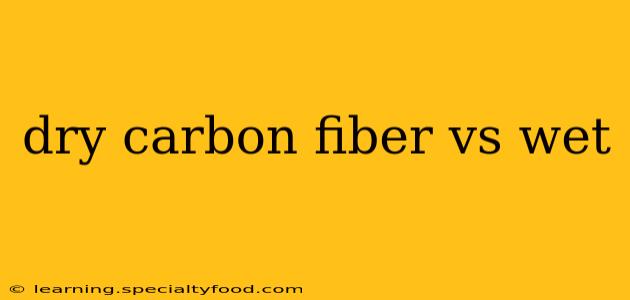Carbon fiber is a remarkable material, prized for its incredible strength-to-weight ratio. However, the manufacturing process significantly impacts the final product's properties and cost. This article delves into the key differences between dry and wet carbon fiber, helping you understand which process is best suited for different applications.
What is Dry Carbon Fiber?
Dry carbon fiber utilizes pre-preg (pre-impregnated) carbon fiber sheets that are already saturated with resin. These sheets are laid up in a mold, and then the mold is placed in an autoclave – a high-pressure oven – to cure the resin. The lack of additional resin application during the layup process is what distinguishes it as "dry." This method offers exceptional control over fiber orientation and resin distribution, resulting in a superior final product.
Advantages of Dry Carbon Fiber:
- Higher Strength-to-Weight Ratio: The precise control over resin content leads to a higher fiber volume fraction, resulting in a stronger and lighter final part.
- Improved Surface Finish: Dry layup often yields a smoother, more aesthetically pleasing surface finish, requiring less post-processing.
- Better Mechanical Properties: Dry carbon fiber components generally exhibit better tensile strength, flexural strength, and impact resistance compared to wet layup.
- Enhanced Dimensional Stability: The controlled resin distribution reduces shrinkage and warping during the curing process, leading to better dimensional accuracy.
Disadvantages of Dry Carbon Fiber:
- Higher Cost: The pre-preg materials and specialized autoclave equipment make dry carbon fiber significantly more expensive than wet layup.
- More Complex Manufacturing Process: Requires skilled technicians and specialized equipment, making it less accessible for smaller-scale production.
- Waste Generation: Pre-preg materials are expensive, and any material waste significantly increases the overall cost.
What is Wet Carbon Fiber?
Wet carbon fiber involves manually applying resin to the dry carbon fiber tows or fabrics during the layup process. This method is simpler and requires less specialized equipment. The resin is then cured, typically in an oven.
Advantages of Wet Carbon Fiber:
- Lower Cost: The materials and equipment required are significantly cheaper than those needed for dry layup.
- Simpler Manufacturing Process: Relatively easier to learn and implement, making it suitable for smaller workshops and less experienced manufacturers.
- Greater Flexibility in Design: Can be used for a wider range of shapes and complexities, although achieving precise fiber orientation is more challenging.
Disadvantages of Wet Carbon Fiber:
- Lower Strength-to-Weight Ratio: The imprecise resin distribution results in a lower fiber volume fraction, leading to a less strong and potentially heavier final product.
- Inferior Surface Finish: Wet layup often requires more post-processing to achieve a smooth surface finish.
- Higher Void Content: The manual resin application can lead to higher void content within the composite material, compromising its strength and durability.
- Increased Potential for Defects: Manual application increases the risk of introducing flaws like improper fiber orientation, air bubbles, or uneven resin distribution.
Dry Carbon Fiber vs. Wet Carbon Fiber: Which is Better?
The "better" method depends entirely on the application. Dry carbon fiber is ideal for high-performance applications where strength, weight, and precision are paramount, such as aerospace components, high-end sports equipment (e.g., racing bicycles, Formula 1 cars), and advanced medical devices. Wet carbon fiber, on the other hand, is more suitable for applications where cost is a major factor and high performance is less critical, including some automotive parts, smaller boat components, and certain industrial applications.
How Does the Manufacturing Process Affect the Final Product?
The manufacturing process significantly influences the final product's properties. Dry carbon fiber's controlled process results in superior strength, lighter weight, and improved surface finish. Wet carbon fiber's more flexible and cost-effective process often compromises on these qualities.
What are the Different Types of Carbon Fiber Layups?
Several layup techniques exist within both dry and wet carbon fiber processes, including unidirectional, bidirectional, and woven fabrics. Each technique influences the final product's strength and stiffness properties.
What are the Applications of Dry and Wet Carbon Fiber?
Dry carbon fiber finds its niche in high-performance applications, while wet carbon fiber serves applications where cost-effectiveness is prioritized.
This detailed comparison highlights the key differences between dry and wet carbon fiber, empowering you to make informed decisions based on your specific needs and priorities. Remember to always consult with experts for complex projects.
